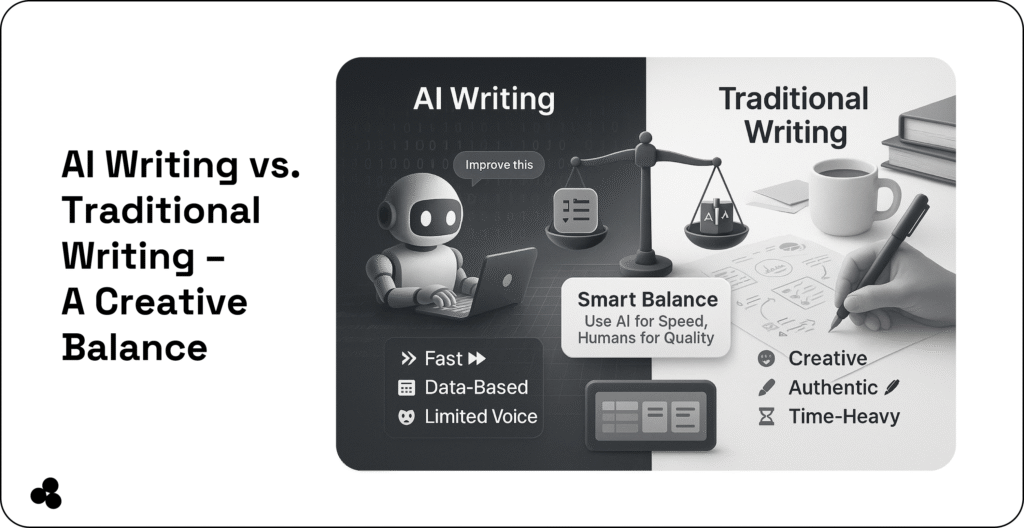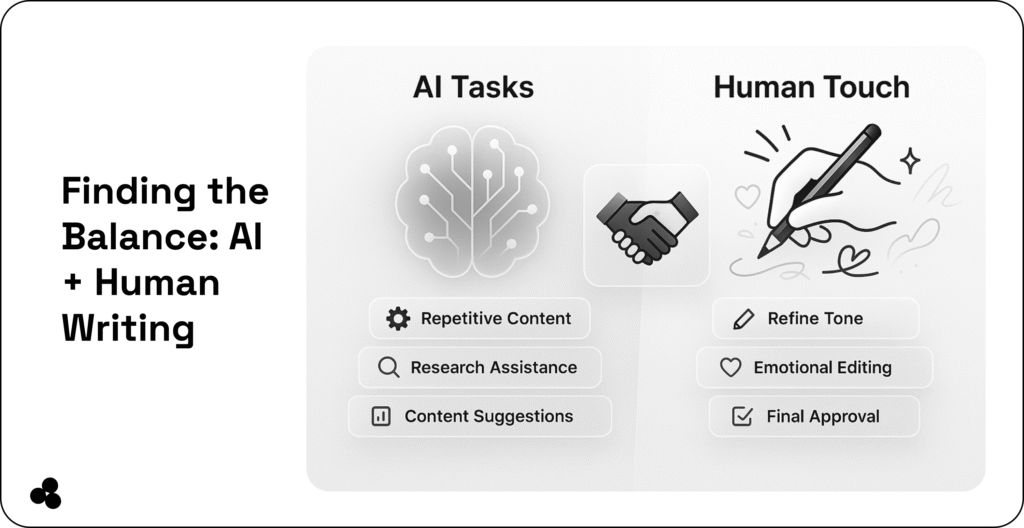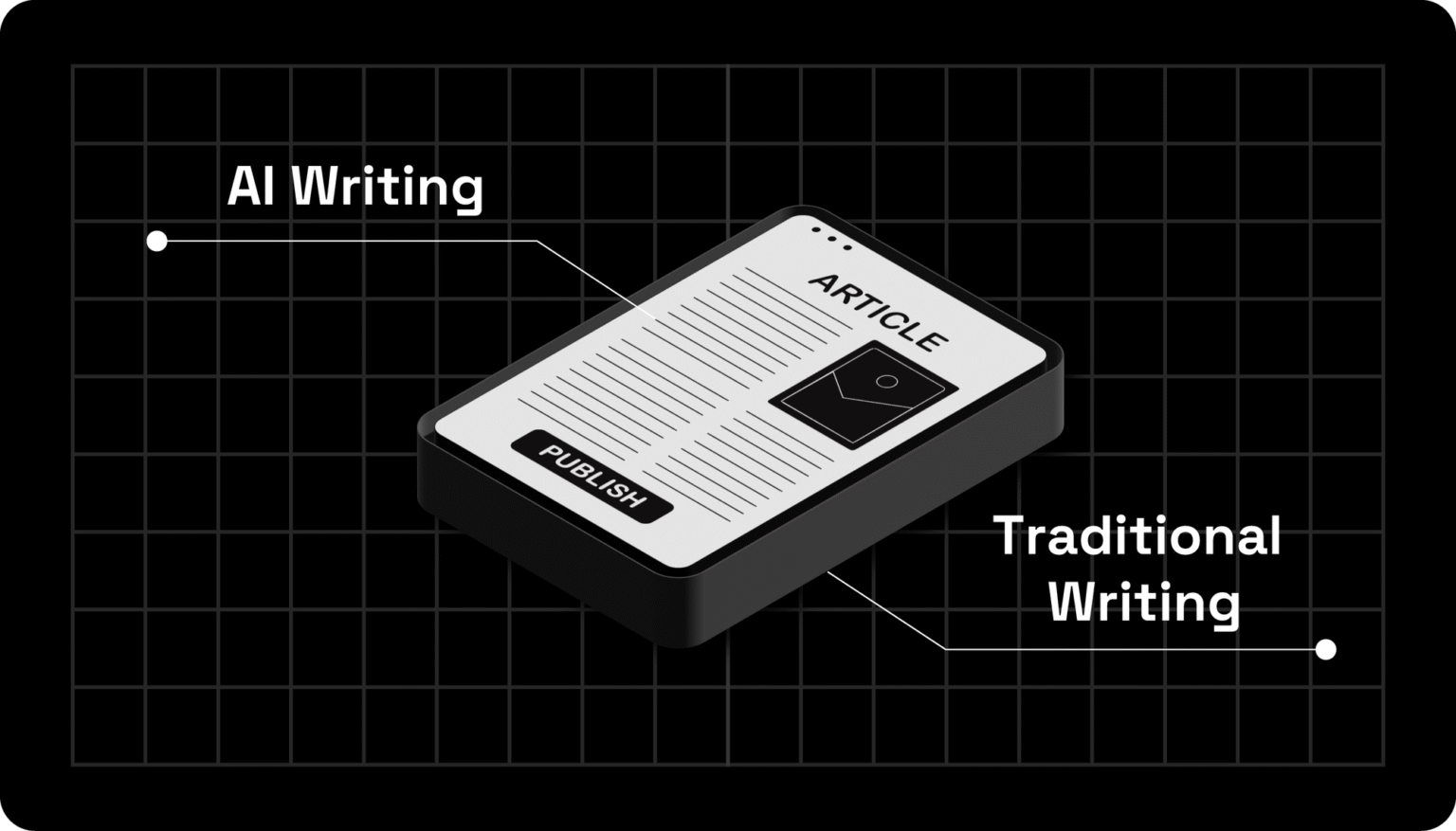Have you ever wondered whether AI can honestly write like a human? Or maybe you’ve tested an AI writing tool and thought, “This is fast—but does it sound authentic?”
In today’s content-driven world, the debate of AI writing vs traditional writing is heating up. From marketers to students, everyone’s asking: Should I trust AI to write, or stick to the human touch?
In this guide, we’ll explore the benefits, drawbacks, and ideal applications of both approaches and show you how to combine them for optimal results.
💡 Related read: AI for Content Marketing

AI Writing vs Traditional Writing Differences
The most significant difference between AI and human writing is the ability to strike a balance between efficiency and engagement.
What Is AI Writing?
AI writing uses artificial intelligence to generate content automatically. Tools like Penman or ChatGPT use machine learning and natural language processing (NLP) to write emails, blog posts, product descriptions, and more in seconds.
AI tools are trained on billions of words, learning structure, grammar, and tone to produce content that sounds human.
✍️ How does AI know what to write? AI analyzes large datasets to predict words and phrases that fit your prompt. It doesn’t “think” creatively—it calculates what’s statistically likely.
If you’re curious about the roots of this technology, read more on the History of Artificial Intelligence.
What Is Traditional Writing?
Traditional writing is fully human-created. It’s where imagination, emotion, and lived experience converge to create unique stories, articles, or copy.
Writers rely on skill, tone, and understanding of their audience—qualities that machines can’t replicate.
✍️ Is traditional writing still relevant in the age of AI? Absolutely. Authentic storytelling, emotional appeal, and critical thinking remain irreplaceable. AI can help, but it can’t replace your human insight.
If you want to sharpen your writing skills, check out these productive writer tips.
AI Writing vs Traditional Writing: Key Differences
| Feature | AI Writing | Traditional Writing |
|---|---|---|
| Speed | Creates drafts in seconds | Requires time and focus |
| Creativity | Limited originality | Deep emotional and narrative flair |
| Cost | Budget-friendly tools | Higher cost for professionals |
| Tone Consistency | Highly consistent | Varies with writer mood |
| Editing Needs | Requires human refinement | Self-edited by the author |
| SEO Optimization | Built-in or automated | Must be applied manually |
| Authenticity | Machine-generated | Genuine and relatable |
| Scalability | Ideal for bulk content | Limited by human capacity |
✍️ Is AI writing better for SEO? It can be—AI can generate keyword-rich content fast, but you still need human editing to ensure quality and originality.
Pros and Cons of AI Writing Tools
Pros:
- Super fast content generation
- Cost-effective for startups and small teams
- Consistent tone and formatting
- Great for SEO and data-driven content
- Excellent for outlines or brainstorming
Cons:
- Lacks emotional nuance
- May produce repetitive or generic phrasing
- No real creativity or personal touch
- Requires fact-checking and proofreading
✍️ Can AI write entire articles on its own? Yes—but it shouldn’t. The best content blends AI’s speed with your human editing and creativity.
💡 Read more: Pros and Cons of AI-Generated Content
Pros and Cons of Traditional Writing
Pros:
- Deep creativity and emotional connection
- Natural storytelling that resonates with readers
- Perfect for brand voice and tone
- Human authenticity builds trust
Cons:
- Time-intensive and harder to scale
- Costlier for businesses producing lots of content
- Risk of writer’s block
- Inconsistent tone across writers
✍️ Can traditional writers use AI tools without losing authenticity? Yes. You can use AI for support, like generating outlines or correcting grammar, without compromising your voice. Try the Grammar Checker or AI Contract Generator to speed up your workflow.

Benefits of Combining AI and Human Writing
Why choose between them when you can combine both?
The most successful teams today utilize a hybrid approach—combining AI for speed with human creativity.
Here’s how it works:
- Use Penman or an AI outline tool for the first draft.
- Edit and refine with your unique voice.
- Run it through a Grammar Checker to polish.
- Add structured formatting with this Beginner’s Guide to Structured Content.
✍️ Is hybrid writing the future? Yes, AI won’t replace writers; it’ll empower them to work faster and smarter.
When to Use AI vs Traditional Writing
| Scenario | Best Method |
|---|---|
| Short-form marketing copy | AI-assisted writing |
| Blog posts, SEO articles | Hybrid (AI + human editing) |
| Creative storytelling | Traditional writing |
| Writing job descriptions | Traditional writing with AI help (see example) |
| Technical or legal documents | AI + human review |
✍️ What industries benefit most from AI writing tools? Marketing, eCommerce, education, and startups—especially those with high content demands.
Common Misconceptions About AI Writing
Let’s clear up a few myths:
- “AI is replacing writers.” → It’s assisting writers, not replacing them.
- “AI writing is always accurate.” → You still need fact-checking and editing.
- “AI has creativity.” → It mimics creativity—it doesn’t truly understand emotion or intent.
Real-World Example
A marketing agency used AI writing tools to draft 100 blog posts per month. The human editors then added nuance, local SEO, and brand personality.
Result?
- 45% faster content production
- 30% lower cost
- Improved engagement and conversion rates
✍️ What’s the best way to measure AI content success? Track engagement, readability, and conversion metrics—not just word count.
Write Smarter, Not Harder
The truth is, there’s no winner in the “AI writing vs traditional writing” debate, only the best blend.
AI offers speed, efficiency, and scalability. Humans bring creativity, emotion, and connection. Together, they form the future of writing.
✅ Use AI tools to streamline your workflow.
✅ Add your personal flair to stand out.
✅ Combine technology with creativity for the perfect balance.
💡 Final Tip: Want to write better, faster, and smarter? Try Penman—your AI-powered writing partner designed to support, not replace, your creativity.








